Leipzig is the largest city in the German federal state of Saxony, with a population of approximately 580,000 (2017). It is the economic center of the region, known as Germany's "Boomtown" and a major cultural center, offering interesting sights, shopping and lively nightlife. The Gewandhausorchester is the biggest and one of the most prominent classical orchestras in Germany, and Leipzig Zoological Garden is one of the most modern zoos in Europe. The Neuseenland outside of Leipzig is a huge lake district.
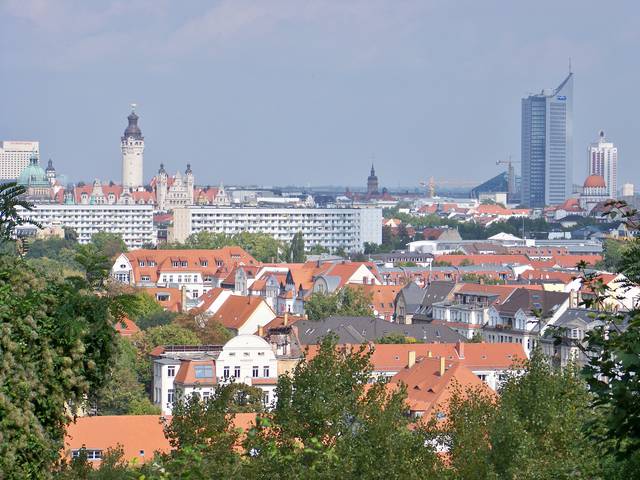
First documented in 1015, and endowed with city and market privileges in 1165, the city of Leipzig has fundamentally shaped the history of Saxony and of Germany. It was founded at the crossing of two ancient trade routes, Via Regia and Via Imperii. Leipzig has always been known as a place of commerce and still has large trade fairgrounds and exhibition halls known as the Leipzig Messe and located north of the city. Before it became common to dedicate a specific area to trade fairs, they took place in the city itself. Which is why many of the historical buildings were constructed by merchants, as well as Leipzig's unique system of arcades and courtyards.
Other forms of exchange soon followed the trade of goods. The University of Leipzig (Latin: Alma mater lipsiensis) was founded in 1409, which makes it the second-oldest university in Germany. University facilities are scattered throughout the city, and you cannot miss the central campus at Augustusplatz. Leipzig acquired the nickname Klein Paris ("Little Paris") in the 18th century, when it became a center of a classical literary movement largely lead by the German scholar and writer Johann Christoph Gottsched.
The city is also the home of the Nikolaikirche (Church of St. Nicholas) – the starting point of peaceful demonstrations against the East German regime which led to German Reunification. The collapse of the Socialist Unity Party of Germany (SED) regime hit Leipzig's economy very heavily (as did communism itself), but after being on the mend for over twenty years, it has emerged as one of the success stories of the "New German States".
Traces of Leipzig's history are everywhere: the ring of streets around the city center marking the former course of the city wall, the city trade houses, abandoned and repurposed industrial buildings in Plagwitz, small town structures in the outskirts where surrounding towns were incorporated during phases of rapid growth, and the battlefields of the Napoleonic wars in the south and southeast of the city.
Today it competes with long time rival Dresden for the title of "biggest city in Saxony" - in the 2011 Census Dresden overtook Leipzig, but according to 2016 estimates, Leipzig has an edge once more. Leipzig's trendy districts are rapidly gentryfying, especially the Südvorstadt neighborhood and it has thus gained the nickname "Hypezig" which is both used derisively and somewhat appreciatively.
- Tourist Information, Katharinenstraße 8 (near Markt in the city center, +49 341 71 04-260. You can download some leaflets from their website.
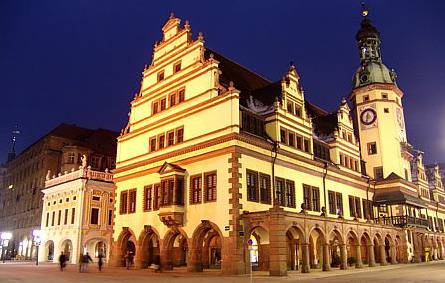
- Old Town Hall, Markt 1, +49 341 9651320. Tu-Su 10:00-18:00, M closed. Built in 1556 in the Renaissance style and remains one of Germany's largest. The position of the tower follows the ancient ideal of "golden mean". Located on the pretty main square of the city, it is a good orientation point. The Old City Hall was built 1556 by Hieronymus Lotter on basements of two Patrician houses. It is a beautiful Renaissance style building, 90 meters long with arcades (1906–09), six gables and a tower. In the 18th century the tower was enlarged and it received a Baroque spire. Until 1904 the Old City Hall was home of the city administration. Then it became home of the city museum. Most impressive is the huge Banquetting Hall with Renaissance interior (open fireplaces). Many fine works of medieval religious art: altars, paintings, wood-carved sculptures etc. Most of them were saved from churches which were deconstructed in Leipzig's surrounding. Very impressive are the rooms with interior from old Patrician houses. Also interesting: the treasure chamber (steep and narrow staircase!). This Renaissance building was erected in just nine months in 1556–57 under the direction of the architect Hieronymus Lotter. The municipal government moved into the New Town Hall in 1909. If you have a bit of luck you are allowed to visit the cellar of the building. Here you find the chamber of torture and the jail. Leipzig's Renaissance City hall contains a museum of city history which possesses the original of the only confirmed painting of Bach produced in his lifetime. It contains interesting information regarding the public executions that previously took place in the market in front of the city hall. The most famous execution was that of Woyzeck later made famous by the Büchner play and the opera of Alban Berg. The interior of the Old City Hall (built in 1556) is far more interesting than the outside view. Inside there's an interesting museum covering the history of Leipzig since its beginning in the 12th century. It is one of the most touristy places of the whole city. €6 adults, €4 concessions.
- New Town Hall, Martin-Luther-Ring 4-6 (, +49 341 123-2323. Seat of the municipal government since 1905. The building also features a 115-m tower which can be accessed by tour M-F at 11:00 and 14:00. Tower tour: €3.
- St. Thomas Church, +49 341 22224-0. Daily 09:00-18:00; churchtower is open weekends only. The church where Johann Sebastian Bach worked as a cantor from 1723 until his death in 1750. His remains are buried under a bronze epitaph near the altar. The Bach Museum is right next to the church. Regular concerts are given by the St. Thomas Boys Choir Fridays and Saturdays (see do section for details). Church: free; church tower: €2.
- Nikolaikirche, Nikolaikirchhof 3. Leipzig's largest church. Starting point for the peaceful revolution on October 9, 1989, when 600 Socialist Unity Party members, who were sent to break up the protest, joined the protesters. Every Monday at 17:00 since 1982, the church holds peace prayers.
- Russische Gedächtniskirche, Philipp-Rosenthal-Straße 51a (Tram 16 to Deutsche Nationalbibliothek. 10:00–13:00 and 14:00–16:00 (winter) or 17:00 (summer). One of the many traces of the Napoleonic wars in and around Leipzig: a memorial church to the honours of Russian soldiers who died during the Napoleonic wars. Admission free, donations welcome.
- Propsteikirche St. Trinitatis, Nonnenmühlgasse 2 (City ring, opposite New Town Hall, +49 341 355 7280. 09:00 - 18:00, outside services. Modern architecture in the style of New Objectivity, covered with a traditional red porphyr stone. Easily to be confused with a modern office building, this church dedicated in 2015 is the largest newly built church building in Eastern Germany since unification. The location is almost on historical ground, as the neighbouring New City Hall is on the spot of the medieval Pleissenburg, where Martin Luther defended his theses in the "Leipzig Debate" of 1519. The steeple, 50 m high goes into contrast to the (still much higher) tower of the New City Hall. During construction the official entrance had to be switched to the back side of the church, as otherwise the postal address would have been "Martin-Luther-Ring", which the Roman Church considered not appropriate and after an attempt to rename the street failed to the opposition of the city administration. Free.
St. Thomas Church, +49 341 22224-0. Daily 09:00-18:00; churchtower is open weekends only. The church where Johann Sebastian Bach worked as a cantor from 1723 until his death in 1750. His remains are buried under a bronze epitaph near the altar. The Bach Museum is right next to the church. Regular concerts are given by the St. Thomas Boys Choir Fridays and Saturdays (see do section for details). Church: free; church tower: €2.
Nikolaikirche, Nikolaikirchhof 3. Leipzig's largest church. Starting point for the peaceful revolution on October 9, 1989, when 600 Socialist Unity Party members, who were sent to break up the protest, joined the protesters. Every Monday at 17:00 since 1982, the church holds peace prayers.
Russische Gedächtniskirche, Philipp-Rosenthal-Straße 51a (Tram 16 to Deutsche Nationalbibliothek. 10:00–13:00 and 14:00–16:00 (winter) or 17:00 (summer). One of the many traces of the Napoleonic wars in and around Leipzig: a memorial church to the honours of Russian soldiers who died during the Napoleonic wars. Admission free, donations welcome.
Propsteikirche St. Trinitatis, Nonnenmühlgasse 2 (City ring, opposite New Town Hall, +49 341 355 7280. 09:00 - 18:00, outside services. Modern architecture in the style of New Objectivity, covered with a traditional red porphyr stone. Easily to be confused with a modern office building, this church dedicated in 2015 is the largest newly built church building in Eastern Germany since unification. The location is almost on historical ground, as the neighbouring New City Hall is on the spot of the medieval Pleissenburg, where Martin Luther defended his theses in the "Leipzig Debate" of 1519. The steeple, 50 m high goes into contrast to the (still much higher) tower of the New City Hall. During construction the official entrance had to be switched to the back side of the church, as otherwise the postal address would have been "Martin-Luther-Ring", which the Roman Church considered not appropriate and after an attempt to rename the street failed to the opposition of the city administration. Free.
- Zeitgeschichtliches Forum, Grimmaische Straße 6 (in the center, +49 341 2220-0. Tu-F 09:00-18:00, Sa Su 10:00-18:00, M closed. Opened in 1999, this is a museum about East Germany (the GDR). There is one permanent exhibition about the life in the GDR and the fall of the GDR; the other exhibition changes about every two months and has similar topics. Free.
- Museum in der "Runden Ecke", Dittrichring 24, +49 341 961-2443. Daily 10:00–18:00. Housed in the former Stasi headquarters, this is an interesting museum documenting the Stasi (GDR secret police) and its methods of controlling and manipulating the people. Displays are in German – there is not much English inside. English audio guides are available for €4. Free.
- Bach-Museum, Thomaskirchof 15/16 (Opposite the Thomas Church, +49 341 9137-202. Tu-Su 10:00-18:00. €8 adults, €6 concessions; free entry every first Tu of the month.
- Museum der bildenden Künste, Katharinenstr. 10, +49 341 21699-0. Housed in a glass cube, this museum features paintings from the 15th century through today. Highlights include paintings by local artists Max Beckman and Max Klinger, as well as Caspar David Friedrich, Lucas Cranach the Younger, and Claude Monet. Permanent collection: €5 adults; temporary exhibitions: €8; combined ticket: €10; free entry every first Wednesday of the month.
- Grassi Museum, Johannisplatz 5, +49 341 2229100. Includes the Museum of Applied Arts, the Museum of Musical Instruments, and Museum of Ethnology. €4–5 per museum.
- Naturkundemuseum, Lortzingstraße 3 (tram 12 to Lortzingstraße or tram 1, 3, 4, 7, 9, 12, 13, 14, 15 to Gördelerring. The museum of natural history, filled with all kinds of taxidermy creatures. As of January 2011, city officials are pondering plans of closing the museum soon and reopening it in a different location later with a redesigned exhibition. In 2016 it's still open, a little old fashioned, but entrance is cheap. €1.
- Torhaus Dölitz, Helenenstraße 24, 04279 (tram 11 to Leinestraße, +49 341 33 89 10 7. W F Sa 10:00–16:00 - subject to change, please call before. Exhibition of pewter figures in historically themed dioramas. The location, the gatehouse and only remainder of an old manor, was one of the hotspots in the battles of the Napoleonic wars. €3.
- Deutsches Kleingärtnermuseum, Aachener Str. 7, 04109 (Tram 1, 2, 14 to Marschnerstraße, Tram 3, 4, 7, 8, 13, 15 to Waldplatz. Tu-Th 10:00–16:00. €2.
- Universitätsbibliothek Bibliotheca Albertina, Beethovenstr.6, 04107 (bus 89 to Wächterstraße or Mozartstraße. M-Sa 08:00-00:00. The university's library.
- Sächsisches Psychiatriemuseum, Mainzer Straße 7 (tram 1, 2, or 14 to Marschnerstraße. W-Sa 13:00-18:00. History of psychiatry.
- Sächsisches Apothekenmuseum, Thomaskirchhof 12, 04109. Tu W F-Su 11:00–17:00, Th 14:00–20:00. Pharmacy museum.
- Schulmuseum, Goerdelerring 20, 04109 (tram to Gottschedstraße, Thomaskirche or Gördelerring. M–F 09:00–16:00. History of schooling. Free.
- Zum Arabischen Coffe Baum, Kleine Fleischergasse 4. 11:00–19:00. A museum about coffee and coffee culture in Europe's oldest continuously operating coffee house. Free.
- Galerie für Zeitgenössische Kunst, Karl-Tauchnitz-Straße 9-11 (tram 2, 8, 9 to Neues Rathaus, or bus 89 to Wächterstraße, +49 341 140 81 0. Tu–F 14:00-19:00; Sa Su 12:00-18:00; free entry on Wednesdays. Changing exhibitions of contemporary art. €8.
- Straßenbahnmuseum, Apelstraße 1 (tram 9 to Historischer Strbf.. May-Sep: 3rd Sunday of the month 10:00-17:00. Dozens of historic trolleys that once ran on Leipzig's tram network. €3.
Zeitgeschichtliches Forum, Grimmaische Straße 6 (in the center, +49 341 2220-0. Tu-F 09:00-18:00, Sa Su 10:00-18:00, M closed. Opened in 1999, this is a museum about East Germany (the GDR). There is one permanent exhibition about the life in the GDR and the fall of the GDR; the other exhibition changes about every two months and has similar topics. Free.
Museum in der "Runden Ecke", Dittrichring 24, +49 341 961-2443. Daily 10:00–18:00. Housed in the former Stasi headquarters, this is an interesting museum documenting the Stasi (GDR secret police) and its methods of controlling and manipulating the people. Displays are in German – there is not much English inside. English audio guides are available for €4. Free.
Bach-Museum, Thomaskirchof 15/16 (Opposite the Thomas Church, +49 341 9137-202. Tu-Su 10:00-18:00. €8 adults, €6 concessions; free entry every first Tu of the month.
Museum der bildenden Künste, Katharinenstr. 10, +49 341 21699-0. Housed in a glass cube, this museum features paintings from the 15th century through today. Highlights include paintings by local artists Max Beckman and Max Klinger, as well as Caspar David Friedrich, Lucas Cranach the Younger, and Claude Monet. Permanent collection: €5 adults; temporary exhibitions: €8; combined ticket: €10; free entry every first Wednesday of the month.
Grassi Museum, Johannisplatz 5, +49 341 2229100. Includes the Museum of Applied Arts, the Museum of Musical Instruments, and Museum of Ethnology. €4–5 per museum.
Naturkundemuseum, Lortzingstraße 3 (tram 12 to Lortzingstraße or tram 1, 3, 4, 7, 9, 12, 13, 14, 15 to Gördelerring. The museum of natural history, filled with all kinds of taxidermy creatures. As of January 2011, city officials are pondering plans of closing the museum soon and reopening it in a different location later with a redesigned exhibition. In 2016 it's still open, a little old fashioned, but entrance is cheap. €1.
Torhaus Dölitz, Helenenstraße 24, 04279 (tram 11 to Leinestraße, +49 341 33 89 10 7. W F Sa 10:00–16:00 - subject to change, please call before. Exhibition of pewter figures in historically themed dioramas. The location, the gatehouse and only remainder of an old manor, was one of the hotspots in the battles of the Napoleonic wars. €3.
Deutsches Kleingärtnermuseum, Aachener Str. 7, 04109 (Tram 1, 2, 14 to Marschnerstraße, Tram 3, 4, 7, 8, 13, 15 to Waldplatz. Tu-Th 10:00–16:00. €2.
Universitätsbibliothek Bibliotheca Albertina, Beethovenstr.6, 04107 (bus 89 to Wächterstraße or Mozartstraße. M-Sa 08:00-00:00. The university's library.
Sächsisches Psychiatriemuseum, Mainzer Straße 7 (tram 1, 2, or 14 to Marschnerstraße. W-Sa 13:00-18:00. History of psychiatry.
Sächsisches Apothekenmuseum, Thomaskirchhof 12, 04109. Tu W F-Su 11:00–17:00, Th 14:00–20:00. Pharmacy museum.
Schulmuseum, Goerdelerring 20, 04109 (tram to Gottschedstraße, Thomaskirche or Gördelerring. M–F 09:00–16:00. History of schooling. Free.
Zum Arabischen Coffe Baum, Kleine Fleischergasse 4. 11:00–19:00. A museum about coffee and coffee culture in Europe's oldest continuously operating coffee house. Free.
Galerie für Zeitgenössische Kunst, Karl-Tauchnitz-Straße 9-11 (tram 2, 8, 9 to Neues Rathaus, or bus 89 to Wächterstraße, +49 341 140 81 0. Tu–F 14:00-19:00; Sa Su 12:00-18:00; free entry on Wednesdays. Changing exhibitions of contemporary art. €8.
Straßenbahnmuseum, Apelstraße 1 (tram 9 to Historischer Strbf.. May-Sep: 3rd Sunday of the month 10:00-17:00. Dozens of historic trolleys that once ran on Leipzig's tram network. €3.
- Mendelssohn House, Goldschmidtstraße 12, +49 341 962882-0. Daily 10:00-18:00. Former home of composer Felix Mendelssohn Bartholdy. Regular concerts are held every Sunday at 11:00. €7.50 adults, €6 concessions; free entry every second Th of the month; Sunday concert tickets generally are €15/€10.
- Schiller House, Menckestraße 42 (Tram 4 "Menckestraße", +49 341 5662170. Apr-Oct: Tu-Su 10:00–17:00; Nov-Mar: W-Su 11:00–16:00. Former home of the poet Friedrich Schiller. This is the (purported) place where he authored the "Ode to Joy". Adults €3, reduced €2, children free.
- Schumann House, Inselstraße 18, +49 341 3939620. M-F 14:00–18:00, Sa Su 10:00–18:00 (sound space only opened on weekends). Former house of musicians and composers Clara and Robert Schumann. Adults €5, children free.
Mendelssohn House, Goldschmidtstraße 12, +49 341 962882-0. Daily 10:00-18:00. Former home of composer Felix Mendelssohn Bartholdy. Regular concerts are held every Sunday at 11:00. €7.50 adults, €6 concessions; free entry every second Th of the month; Sunday concert tickets generally are €15/€10.
Schiller House, Menckestraße 42 (Tram 4 "Menckestraße", +49 341 5662170. Apr-Oct: Tu-Su 10:00–17:00; Nov-Mar: W-Su 11:00–16:00. Former home of the poet Friedrich Schiller. This is the (purported) place where he authored the "Ode to Joy". Adults €3, reduced €2, children free.
Schumann House, Inselstraße 18, +49 341 3939620. M-F 14:00–18:00, Sa Su 10:00–18:00 (sound space only opened on weekends). Former house of musicians and composers Clara and Robert Schumann. Adults €5, children free.
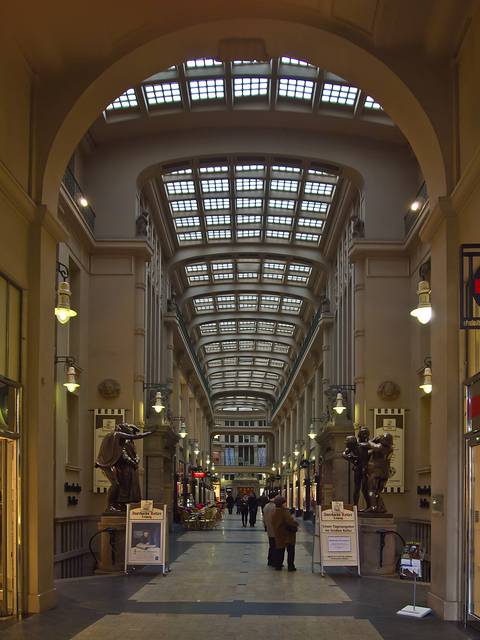
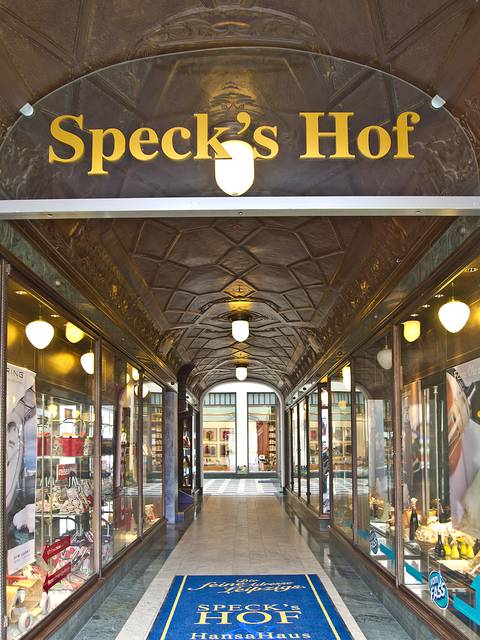 Unique to Leipzig is its number of passages in the city center. Some have big entrances, while others may look from the street just like a gate left open. Some belong to historical buildings, some have appeared only a few years ago.
Unique to Leipzig is its number of passages in the city center. Some have big entrances, while others may look from the street just like a gate left open. Some belong to historical buildings, some have appeared only a few years ago.
- Mädlerpassage, Grimmaische Straße/Neumarkt. Upscale shops and bars. The entrance to Auerbachs Keller is inside. Forms a bigger system with Königshauspassage and Messehofpassage.
- Barthels Hof, Hainstraße/Barfußgäßchen.
- Speck's Hof and Hansahaus, Nikolaistraße/Reichsstraße/Grimmaische Straße. The oldest passage in Leipzig.
- Jägerhofpassage, Hainstraße/Große Fleischergasse. Calm atmosphere in the middle of the city. Inside you'll find the arthouse cinema Passage Kinos.
- Städtisches Kaufhaus, Neumarkt/Universitätsstraße/Kupfergasse/Gewandgäßchen.
Mädlerpassage, Grimmaische Straße/Neumarkt. Upscale shops and bars. The entrance to Auerbachs Keller is inside. Forms a bigger system with Königshauspassage and Messehofpassage.
Barthels Hof, Hainstraße/Barfußgäßchen.
Speck's Hof and Hansahaus, Nikolaistraße/Reichsstraße/Grimmaische Straße. The oldest passage in Leipzig.
Jägerhofpassage, Hainstraße/Große Fleischergasse. Calm atmosphere in the middle of the city. Inside you'll find the arthouse cinema Passage Kinos.
Städtisches Kaufhaus, Neumarkt/Universitätsstraße/Kupfergasse/Gewandgäßchen.
- Romanushaus and Fregehaus, Katharinenstraße 23 (city center near tourist information. Baroque architecture.
- Rundling, Siegfriedplatz, Siegfriedstraße (Tram 16 to Lößnig or tram 11 to Raschwitzer Straße or local train to Leipzig-Connewitz. Apartment houses in concentric circles, built in the late 1920s/early 1930s. Streets are named after characters from the "Song of the Nibelungs".
- Stalin era architecture, Roßplatz (Tram to Augustusplatz or Roßplatz. Curved to follow the street, huge like a castle -- Leipzig's most prominent relic of the Stalin era sits at the Ring next to the Gewandhaus.
- Waldstraßenviertel. Europe's largest uninterrupted Gründerzeit district.
- Plagwitz. An industrial district whose time of glory has passed. Many of its factories died a slow death during the GDR years, which suddenly became visible with the reunification of Germany. Today it is a mixture of old industrial buildings, some in ruins and others repurposed; fallow land; and new developments. Walk around Karl-Heine Straße between Felsenkeller and the railway station Bahnhof Plagwitz, Weißenfelser Straße and Gießerstraße to get a feeling for the place, or walk the path alongside the Karl-Heine Kanal. May appear a bit spooky at night.
- Meyersche Häuser, Several locations: Herrmann-Meyer-Straße in Kleinzschocher; between Erich-Köhn Straße and Demmeringstraße in Lindenau; Hofer Straße in Reudnitz; between Bernburger Straße and Theresienstraße, Hamburger Straße and Schönfelder Straße in Eutritzsch. Herrmann Julius Meyer, owner of a publishing company, initiated in the late 19th century several development projects to provide adequate but cheap housing to factory workers and their families.
- Early highrise buildings, Augustusplatz. You can see two early highrise buildings (by the standards of their time) around Augustusplatz. One is the Krochhochaus on the western side of the square. The other is the Europahaus in the southeastern corner of the square, across the street from the Gewandhaus.
- Krochhochhaus, Goethestraße 2.
- Europahaus, Augustusplatz 7.
- Modern highrise buildings, Augustusplatz, Wintergartenstraße and Nordstraße. Besides the tower of the new townhall and the Völkerschlachtenkmal, three highrise buildings shape the skyline of Leipzig. The City-Hochhaus (Augustusplatz) was built as part of the university campus but sold to private investors in the 1990s. The Wintergartenhochhaus next to the Hauptbahnhof (Wintergartenstraße) is an apartment building. The Westin hotel was erected in the late 1970s and opened in 1981 as Hotel Merkur.
- Panorama Tower, Augustusplatz (the highrise between Gewandhaus and university, +49 341-7100590. Restaurant: M–F 11:00–00:00, Sa 11:00–01:00, Su 11:00–23:00; observation platform open from 09:00. Leipzig's highest building has a restaurant and an observation platform at its top with a great view over the town. €3 (observation platform).
- Wintergartenhochhaus.
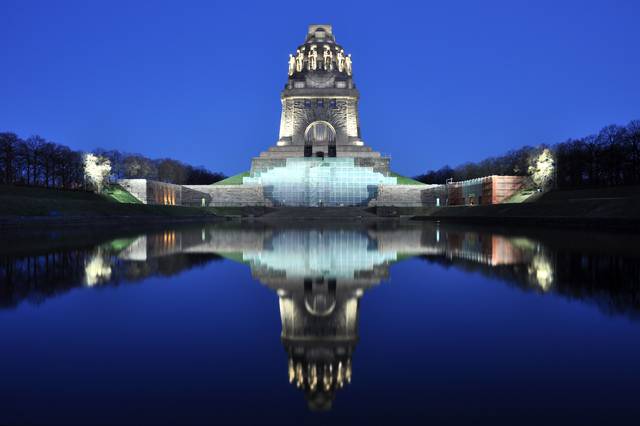
Romanushaus and Fregehaus, Katharinenstraße 23 (city center near tourist information. Baroque architecture.
Rundling, Siegfriedplatz, Siegfriedstraße (Tram 16 to Lößnig or tram 11 to Raschwitzer Straße or local train to Leipzig-Connewitz. Apartment houses in concentric circles, built in the late 1920s/early 1930s. Streets are named after characters from the "Song of the Nibelungs".
Stalin era architecture, Roßplatz (Tram to Augustusplatz or Roßplatz. Curved to follow the street, huge like a castle -- Leipzig's most prominent relic of the Stalin era sits at the Ring next to the Gewandhaus.
Waldstraßenviertel. Europe's largest uninterrupted Gründerzeit district.
Plagwitz. An industrial district whose time of glory has passed. Many of its factories died a slow death during the GDR years, which suddenly became visible with the reunification of Germany. Today it is a mixture of old industrial buildings, some in ruins and others repurposed; fallow land; and new developments. Walk around Karl-Heine Straße between Felsenkeller and the railway station Bahnhof Plagwitz, Weißenfelser Straße and Gießerstraße to get a feeling for the place, or walk the path alongside the Karl-Heine Kanal. May appear a bit spooky at night.
Meyersche Häuser, Several locations: Herrmann-Meyer-Straße in Kleinzschocher; between Erich-Köhn Straße and Demmeringstraße in Lindenau; Hofer Straße in Reudnitz; between Bernburger Straße and Theresienstraße, Hamburger Straße and Schönfelder Straße in Eutritzsch. Herrmann Julius Meyer, owner of a publishing company, initiated in the late 19th century several development projects to provide adequate but cheap housing to factory workers and their families.
Early highrise buildings, Augustusplatz. You can see two early highrise buildings (by the standards of their time) around Augustusplatz. One is the Krochhochaus on the western side of the square. The other is the Europahaus in the southeastern corner of the square, across the street from the Gewandhaus.
- Krochhochhaus, Goethestraße 2.
- Europahaus, Augustusplatz 7.
Early highrise buildings, Augustusplatz. You can see two early highrise buildings (by the standards of their time) around Augustusplatz. One is the Krochhochaus on the western side of the square. The other is the Europahaus in the southeastern corner of the square, across the street from the Gewandhaus.
- Krochhochhaus, Goethestraße 2.
- Europahaus, Augustusplatz 7.
Early highrise buildings, Augustusplatz. You can see two early highrise buildings (by the standards of their time) around Augustusplatz. One is the Krochhochaus on the western side of the square. The other is the Europahaus in the southeastern corner of the square, across the street from the Gewandhaus.
- Krochhochhaus, Goethestraße 2.
- Europahaus, Augustusplatz 7.
Modern highrise buildings, Augustusplatz, Wintergartenstraße and Nordstraße. Besides the tower of the new townhall and the Völkerschlachtenkmal, three highrise buildings shape the skyline of Leipzig. The City-Hochhaus (Augustusplatz) was built as part of the university campus but sold to private investors in the 1990s. The Wintergartenhochhaus next to the Hauptbahnhof (Wintergartenstraße) is an apartment building. The Westin hotel was erected in the late 1970s and opened in 1981 as Hotel Merkur.
- Panorama Tower, Augustusplatz (the highrise between Gewandhaus and university, +49 341-7100590. Restaurant: M–F 11:00–00:00, Sa 11:00–01:00, Su 11:00–23:00; observation platform open from 09:00. Leipzig's highest building has a restaurant and an observation platform at its top with a great view over the town. €3 (observation platform).
- Wintergartenhochhaus.
Modern highrise buildings, Augustusplatz, Wintergartenstraße and Nordstraße. Besides the tower of the new townhall and the Völkerschlachtenkmal, three highrise buildings shape the skyline of Leipzig. The City-Hochhaus (Augustusplatz) was built as part of the university campus but sold to private investors in the 1990s. The Wintergartenhochhaus next to the Hauptbahnhof (Wintergartenstraße) is an apartment building. The Westin hotel was erected in the late 1970s and opened in 1981 as Hotel Merkur.
- Panorama Tower, Augustusplatz (the highrise between Gewandhaus and university, +49 341-7100590. Restaurant: M–F 11:00–00:00, Sa 11:00–01:00, Su 11:00–23:00; observation platform open from 09:00. Leipzig's highest building has a restaurant and an observation platform at its top with a great view over the town. €3 (observation platform).
- Wintergartenhochhaus.
Modern highrise buildings, Augustusplatz, Wintergartenstraße and Nordstraße. Besides the tower of the new townhall and the Völkerschlachtenkmal, three highrise buildings shape the skyline of Leipzig. The City-Hochhaus (Augustusplatz) was built as part of the university campus but sold to private investors in the 1990s. The Wintergartenhochhaus next to the Hauptbahnhof (Wintergartenstraße) is an apartment building. The Westin hotel was erected in the late 1970s and opened in 1981 as Hotel Merkur.
- Panorama Tower, Augustusplatz (the highrise between Gewandhaus and university, +49 341-7100590. Restaurant: M–F 11:00–00:00, Sa 11:00–01:00, Su 11:00–23:00; observation platform open from 09:00. Leipzig's highest building has a restaurant and an observation platform at its top with a great view over the town. €3 (observation platform).
- Wintergartenhochhaus.
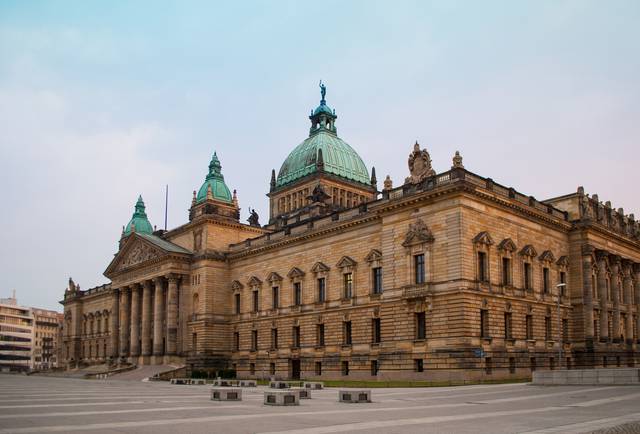
- Völkerschlachtdenkmal. Apr–Oct: 10:00–18:00, November–March 10:00–16:00. At 91m tall, this is the biggest monument in Europe, commemorating the Battle of Leipzig in the Napoleonic Wars, in which the combined Prussian, Austrian, and Russian forces defeated Napoleon at a cost of 100,000 lives. The top platform can be visited (steep, narrow stairs). Every summer, the 'bath tub' race is held in the reflecting pool below. The monument itself was built for the first centennial of the battle and its design reflects the spirit of these times as well as numerous Masonic symbols given that the architect was a Freemason. Adults €6; students €4; children under 6 free.
- University of Leipzig Botanical Garden, Linnéstraße 1 (Tram 12, 15 to Ostplatz or tram 2, 16 to Johannisallee, +49 341 - 9736850. Gardens: Nov–Feb 09:00–16:00; Mar Apr Oct 09:00–18:00; May–Sep 09:00–20:00. Greenhouses: Oct–Apr Tu–F 13:00–16:00, Sa Su 10:00–16:00; May–Sep open until 18:00. It's the oldest one in Germany and one of the first in the world.
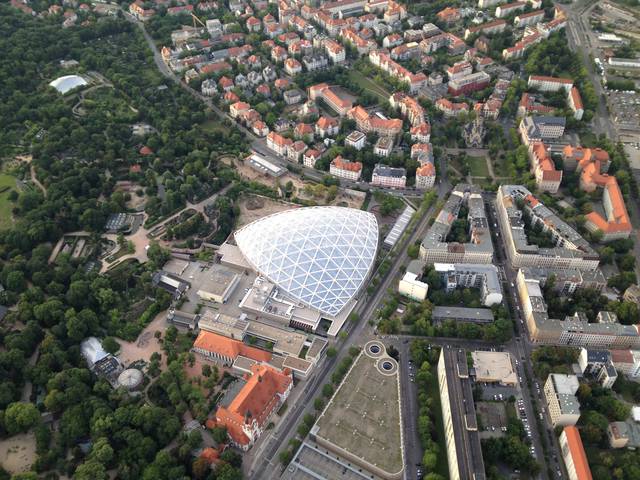
- Leipzig Zoo, Pfaffendorfer Straße 29 (Take Tram 12 to Zoo. Although pricey, this is one of the largest and best known zoos in Germany. In a survey of zoos by Anthony Sheridan, it was ranked first in Germany and second in Europe. New elephants' enclosure has a swimming pool where you can watch the elephants bathing from under the water level. Visit the Gondwanaland tropical species exhibit, where animals and visitors are not separated by either fence or pane, and the monkey house. Adult €17.
- Deutsche Nationalbibliothek, Deutscher Platz 1 (Tram 16 to Deutsche Nationalbibliothek. M–F 08:00–22:00; Sa 09:00–18:00. The national library of Germany collects works published in Germany or in the German language. It consists of three buildings from different epochs: the original main building opened in 1916 with two later extensions integrated, a windowless depot tower from the late 1970s/early 1980s, and book-shaped fourth extension. The center of the main building is a large reading room worth a visit just for its atmosphere. If you wish to use the library or just move around freely you will have to pay a fee and provide government-issued photo ID. If you ask the security guards nicely, they may accompany you to the entrance of the reading room and let you glimpse into it. No photography. €5 for day pass (photo ID required); brief glimpse into reading room free.
- Leipziger Baumwollspinnerei, Spinnereistraße 7 (tram 14 or train to Bahnhof Plagwitz, or tram 8, 15 to Lindenau. A converted cotton mill in the Plagwitz industrial district, today providing work and exhibition rooms to artists.
- Bayerischer Bahnhof, Bayrischer Platz (S-Bahn; Tram 2, 9, 16 or Bus 60 to Bayerischer Platz. Germany's oldest preserved railway station, built in 1842, only 7 years after the first train line of Germany had been opened. The station is no longer in use but one can still view the portal. In the course of the construction of the city tunnel the entire portal was moved away and later relocated to its original place. A new underground station is used by all S-Bahn-trains.
- Reichsgericht, Simsonplatz 1 (tram 2, 8, 9 to Neues Rathaus. M–F 08:00–16:00. Located across the ring southwest of the New Town Hall (Neues Rathaus), the appearance of this building resembles the original look of the Reichstag in Berlin. It was built from 1888 to 1895 for the Court of the German Empire (Reichsgericht), the highest court of the Reich. During the GDR years the building served a variety of uses and hosted the Museum der Bildenden Künste. After refurbishment, the Federal Administrative Court (Bundesverwaltungsgericht) moved into the Reichsgericht building in 2002. You can visit the entrance hall, the large courtroom, and the Reichsgerichtsmuseum with an exhibition on the history of the building. Visitor access may get restricted without prior notice if the work of the court requires it. Admission free; €1 for cloakroom or locker.

- Asisi Panometer, Richard-Lehmann Straße 114, 04275 (Bus 70 to Altenburger Straße. Tu–F 09:00–21:00; Sa Su & bank holidays 10:00–20:00; M closed. Huge panoramic picture surrounding the viewer. The theme changes from time to time. It was built as a gas storage tank. €10.
- Exhibition centre, Messe-Allee 1 (Tram 16 "Messegelände". Leipzig has a long tradition of trade fairs, once having hosted the first and biggest sample fair in Central Europe. The modern exhibition centre was one of the major business investments and architectural innovations of the 1990s post-reunification period ("Aufbau Ost", i.e. "developing the East"). It consists of the distinctive glass hall (a landmark when entering Leipzig from the north), five exhibition halls and a conference centre. In addition to numerous exhibitions and conferences that are only of interest to businesspeople and experts, there is a number of popular fairs geared to the general public, namely the Leipzig book fair (March; cf. #Festivals), House–Garden–Leisure (February), Model–Hobby–Games (late-September/early-October), and Tourism & Caravaning (November).
Völkerschlachtdenkmal. Apr–Oct: 10:00–18:00, November–March 10:00–16:00. At 91m tall, this is the biggest monument in Europe, commemorating the Battle of Leipzig in the [[Napoleonic Wars]], in which the combined Prussian, Austrian, and Russian forces defeated Napoleon at a cost of 100,000 lives. The top platform can be visited (steep, narrow stairs). Every summer, the 'bath tub' race is held in the reflecting pool below. The monument itself was built for the first centennial of the battle and its design reflects the spirit of these times as well as numerous Masonic symbols given that the architect was a Freemason. Adults €6; students €4; children under 6 free.
University of Leipzig Botanical Garden, Linnéstraße 1 (Tram 12, 15 to Ostplatz or tram 2, 16 to Johannisallee, +49 341 - 9736850. Gardens: Nov–Feb 09:00–16:00; Mar Apr Oct 09:00–18:00; May–Sep 09:00–20:00. Greenhouses: Oct–Apr Tu–F 13:00–16:00, Sa Su 10:00–16:00; May–Sep open until 18:00. It's the oldest one in Germany and one of the first in the world.
Leipzig Zoo, Pfaffendorfer Straße 29 (Take Tram 12 to Zoo. Although pricey, this is one of the largest and best known zoos in Germany. In a survey of zoos by Anthony Sheridan, it was ranked first in Germany and second in Europe. New elephants' enclosure has a swimming pool where you can watch the elephants bathing from under the water level. Visit the Gondwanaland tropical species exhibit, where animals and visitors are not separated by either fence or pane, and the monkey house. Adult €17.
Deutsche Nationalbibliothek, Deutscher Platz 1 (Tram 16 to Deutsche Nationalbibliothek. M–F 08:00–22:00; Sa 09:00–18:00. The national library of Germany collects works published in Germany or in the German language. It consists of three buildings from different epochs: the original main building opened in 1916 with two later extensions integrated, a windowless depot tower from the late 1970s/early 1980s, and book-shaped fourth extension. The center of the main building is a large reading room worth a visit just for its atmosphere. If you wish to use the library or just move around freely you will have to pay a fee and provide government-issued photo ID. If you ask the security guards nicely, they may accompany you to the entrance of the reading room and let you glimpse into it. No photography. €5 for day pass (photo ID required); brief glimpse into reading room free.
Leipziger Baumwollspinnerei, Spinnereistraße 7 (tram 14 or train to Bahnhof Plagwitz, or tram 8, 15 to Lindenau. A converted cotton mill in the Plagwitz industrial district, today providing work and exhibition rooms to artists.
Bayerischer Bahnhof, Bayrischer Platz (S-Bahn; Tram 2, 9, 16 or Bus 60 to Bayerischer Platz. Germany's oldest preserved railway station, built in 1842, only 7 years after the first train line of Germany had been opened. The station is no longer in use but one can still view the portal. In the course of the construction of the city tunnel the entire portal was moved away and later relocated to its original place. A new underground station is used by all S-Bahn-trains.
Reichsgericht, Simsonplatz 1 (tram 2, 8, 9 to Neues Rathaus. M–F 08:00–16:00. Located across the ring southwest of the New Town Hall (Neues Rathaus), the appearance of this building resembles the original look of the Reichstag in [[Berlin]]. It was built from 1888 to 1895 for the Court of the German Empire (Reichsgericht), the highest court of the Reich. During the GDR years the building served a variety of uses and hosted the Museum der Bildenden Künste. After refurbishment, the Federal Administrative Court (Bundesverwaltungsgericht) moved into the Reichsgericht building in 2002. You can visit the entrance hall, the large courtroom, and the Reichsgerichtsmuseum with an exhibition on the history of the building. Visitor access may get restricted without prior notice if the work of the court requires it. Admission free; €1 for cloakroom or locker.
Asisi Panometer, Richard-Lehmann Straße 114, 04275 (Bus 70 to Altenburger Straße. Tu–F 09:00–21:00; Sa Su & bank holidays 10:00–20:00; M closed. Huge panoramic picture surrounding the viewer. The theme changes from time to time. It was built as a gas storage tank. €10.
Exhibition centre, Messe-Allee 1 (Tram 16 "Messegelände". Leipzig has a long tradition of trade fairs, once having hosted the first and biggest sample fair in Central Europe. The modern exhibition centre was one of the major business investments and architectural innovations of the 1990s post-reunification period ("Aufbau Ost", i.e. "developing the East"). It consists of the distinctive glass hall (a landmark when entering Leipzig from the north), five exhibition halls and a conference centre. In addition to numerous exhibitions and conferences that are only of interest to businesspeople and experts, there is a number of popular fairs geared to the general public, namely the Leipzig book fair (March; cf. [[#Festivals]]), House–Garden–Leisure (February), Model–Hobby–Games (late-September/early-October), and Tourism & Caravaning (November).
Old Town Hall, Markt 1, +49 341 9651320. Tu-Su 10:00-18:00, M closed. Built in 1556 in the Renaissance style and remains one of Germany's largest. The position of the tower follows the ancient ideal of "golden mean". Located on the pretty main square of the city, it is a good orientation point. The Old City Hall was built 1556 by Hieronymus Lotter on basements of two Patrician houses. It is a beautiful Renaissance style building, 90 meters long with arcades (1906–09), six gables and a tower. In the 18th century the tower was enlarged and it received a Baroque spire. Until 1904 the Old City Hall was home of the city administration. Then it became home of the city museum. Most impressive is the huge Banquetting Hall with Renaissance interior (open fireplaces). Many fine works of medieval religious art: altars, paintings, wood-carved sculptures etc. Most of them were saved from churches which were deconstructed in Leipzig's surrounding. Very impressive are the rooms with interior from old Patrician houses. Also interesting: the treasure chamber (steep and narrow staircase!). This Renaissance building was erected in just nine months in 1556–57 under the direction of the architect Hieronymus Lotter. The municipal government moved into the New Town Hall in 1909. If you have a bit of luck you are allowed to visit the cellar of the building. Here you find the chamber of torture and the jail. Leipzig's Renaissance City hall contains a museum of city history which possesses the original of the only confirmed painting of Bach produced in his lifetime. It contains interesting information regarding the public executions that previously took place in the market in front of the city hall. The most famous execution was that of Woyzeck later made famous by the Büchner play and the opera of Alban Berg. The interior of the Old City Hall (built in 1556) is far more interesting than the outside view. Inside there's an interesting museum covering the history of Leipzig since its beginning in the 12th century. It is one of the most touristy places of the whole city. €6 adults, €4 concessions.
New Town Hall, Martin-Luther-Ring 4-6 (, +49 341 123-2323. Seat of the municipal government since 1905. The building also features a 115-m tower which can be accessed by tour M-F at 11:00 and 14:00. Tower tour: €3.
If you understand some German, get a copy of the monthly city magazine Kreuzer or use the event calendar on their website to get information on upcoming events. You can buy the Kreuzer for €2.50 in press shops and bookstores throughout the city.
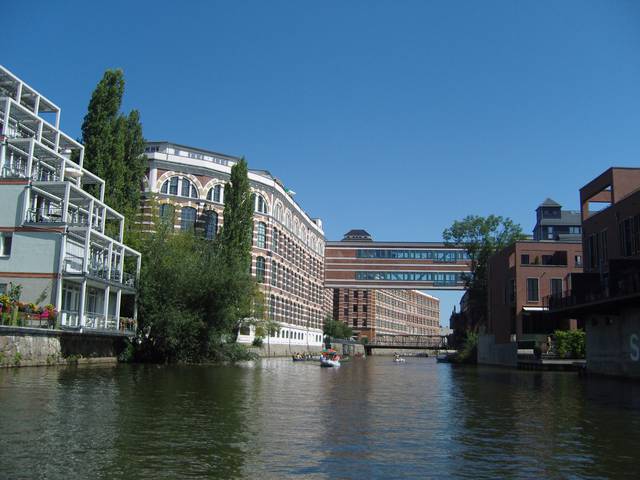
- Sightseeing tour, Katharinenstaße 8 (starts at Tourist Information, ends on Augustusplatz, +49 341-71 04-230. Daily 13:30 (in German also 10:30). The tour lasts 2½ hours, comprising a 1-hour guided walk through the city center and a bus tour of 1½ hours to sights elsewhere. You can also book each part of the tour individually. Buy your ticket at tourist information, where the tour starts. €15.
- Sightseeing by tram, Kurt-Schumacher Straße (coming from Hauptbahnhof/Westhalle, walk a few steps towards Berliner Straße/Wilhelm-Liebknecht Platz, +49 341-19449. Saturdays, starting at 11:00 and 14:00; May–September also Sundays 11:00. Every weekend, LVB offers sightseeing tours in a modified tram called "Gläserner Leipziger". Buy your ticket in advance from any of the LVB service offices listed above; it includes a day ticket for zone 110 (Leipzig) of the MDV network. The tour takes about 2 hours. €15 per person.
- VideoBustour, Lützowstr. 19 (starts and ends when and where you want, +49 341-902 902 89. individual starting time for small groups. In addition to the comments of a live guide in English or other languages, on-screen historic film footage and photographs give you a deeper insight into Leipzigs history and life today. The standard length of the tour is 2 hours. You can also combine it with a walking tour through the historic center. from €25.
Sightseeing tour, Katharinenstaße 8 (starts at Tourist Information, ends on Augustusplatz, +49 341-71 04-230. Daily 13:30 (in German also 10:30). The tour lasts 2½ hours, comprising a 1-hour guided walk through the city center and a bus tour of 1½ hours to sights elsewhere. You can also book each part of the tour individually. Buy your ticket at tourist information, where the tour starts. €15.
Sightseeing by tram, Kurt-Schumacher Straße (coming from Hauptbahnhof/Westhalle, walk a few steps towards Berliner Straße/Wilhelm-Liebknecht Platz, +49 341-19449. Saturdays, starting at 11:00 and 14:00; May–September also Sundays 11:00. Every weekend, LVB offers sightseeing tours in a modified tram called "Gläserner Leipziger". Buy your ticket in advance from any of the LVB service offices listed above; it includes a day ticket for zone 110 (Leipzig) of the MDV network. The tour takes about 2 hours. €15 per person.
VideoBustour, Lützowstr. 19 (starts and ends when and where you want, +49 341-902 902 89. individual starting time for small groups. In addition to the comments of a live guide in English or other languages, on-screen historic film footage and photographs give you a deeper insight into Leipzigs history and life today. The standard length of the tour is 2 hours. You can also combine it with a walking tour through the historic center. from €25.
- Gewandhaus, Augustusplatz, +49 341 1270 280 (Tickets). Mendelssohn's orchestra still exists, but the concert hall is new. Inside is a huge painting by Sighard Gille, visible through the windows from Augustusplatz.
- Motets in St. Thomas Church, Thomaskirche, Thomaskirchhof. Friday 18:00 and Saturday 15:00; unreserved seating, come early (church opens 45 min before). Listen to the St. Thomas Boys Choir performing Bach's music in its original environment. Be aware that a guest choir may sing instead at any time as the St Thomas Choir travels a lot. Since the motet is primarily a musical form of devotion and not a musical performance for tourists, applause is uncommon and frowned upon. Admission €2 (includes program); children free.
- Oper Leipzig, Augustusplatz, +49 341 1261261 (Tickets). The opera house of Leipzig. Though the building was opened in 1960, the company looks back at more than 300 years of history.
Gewandhaus, Augustusplatz, +49 341 1270 280 (Tickets). Mendelssohn's orchestra still exists, but the concert hall is new. Inside is a huge painting by Sighard Gille, visible through the windows from Augustusplatz.
Motets in St. Thomas Church, Thomaskirche, Thomaskirchhof. Friday 18:00 and Saturday 15:00; unreserved seating, come early (church opens 45 min before). Listen to the St. Thomas Boys Choir performing Bach's music in its original environment. Be aware that a guest choir may sing instead at any time as the St Thomas Choir travels a lot. Since the motet is primarily a musical form of devotion and not a musical performance for tourists, applause is uncommon and frowned upon. Admission €2 (includes program); children free.
Oper Leipzig, Augustusplatz, +49 341 1261261 (Tickets). The opera house of Leipzig. Though the building was opened in 1960, the company looks back at more than 300 years of history.
- Bach Festival. Late May-early June. Organized by the Bach Museum.
- Leipziger Buchmesse. Late March. Besides the main event on the fairground, readings take place in various locations around the city.
- Wave-Gotik-Treffen Leipzig. Date follows Pentecost, late May or early June. World's largest goth festival includes a pagan village, medieval market, and goth music.
- Leipziger Kleinmesse, Cottaweg (Tram 3, 7, 8, 15 to Angerbrücke. Funfair, twice a year in spring (April/May) and fall (September/October).
- Saxonia International Balloon Fiesta, Leipzig-Lößnig (Tram 10 or 16 to Lößnig. late July. Meeting of hot air balloon pilots. Lots of flying balloons if the weather permits flying. (Not in 2019.)
- Euro-Scene. mid-November. Festival of contemporary European theatre.
- International Festival for Documentary and Animated Film. every October.
Bach Festival. Late May-early June. Organized by the Bach Museum.
Leipziger Buchmesse. Late March. Besides the main event on the fairground, readings take place in various locations around the city.
Wave-Gotik-Treffen Leipzig. Date follows Pentecost, late May or early June. World's largest goth festival includes a pagan village, medieval market, and goth music.
Leipziger Kleinmesse, Cottaweg (Tram 3, 7, 8, 15 to Angerbrücke. Funfair, twice a year in spring (April/May) and fall (September/October).
Saxonia International Balloon Fiesta, Leipzig-Lößnig (Tram 10 or 16 to Lößnig. late July. Meeting of hot air balloon pilots. Lots of flying balloons if the weather permits flying. (Not in 2019.)
Euro-Scene. mid-November. Festival of contemporary European theatre.
International Festival for Documentary and Animated Film. every October.
- Leipzig Riverside Forest. With an area of 2500 hectares (6180 acres), it is one of the largest riparian forests in Central Europe and one of the largest urban forests in Germany. Having an extensive forest—not on the outskirts, but in the middle of the city—is a defining feature of Leipzig. It stretches along the rivers Pleiße, Weiße Elster, and their tributaries, for more than 30 km in length and 2 to 5 km in width. Some parts are designed as landscape gardens while others are left in a near-natural state and protected as conservation areas. This "green belt" may be discovered on a walk, by bicycle, on horseback or during a canoe ride. From the Cospudener See in the south through the Clara-Zetkin-Park, west of the city center along the Elsterflutbecken, and to the northwest between Leutzsch and Möckern you'll find a landscape that sometimes makes you forget you are in a city.
- Clara-Zetkin Park. Really a collection of several parks that locals may still know and refer to by their original names: Johannapark, Albertpark, Volkspark Scheibenholz, and Palmengarten. Walk westwards from the new city hall to find the Johannapark, starting at the crossing of Karl-Tauchnitz Straße and Friedrich-Ebert Straße
- Rosental. The second largest park of Leipzig, located northwest of the city center. From the Rosental you can get a glimpse into the zoo without having to pay the entrance fee (Zooschaufenster near the large meadow). Crossing Waldstraße and continuing in northwestern direction you will find a small hill with a watchtower on top.
- Aussichtsturm Rosentalhügel. Observation tower. See the city from above. Admission is free. You'll have to climb up stairs in the open and stand on a platform that may shake a bit in the wind. Free.
- Fockeberg. This hill was built as a landfill for World War II debris. It is now a park and the location for several recurrent events: the Fockeberglauf in March and November (a running competition), the Fockebergzeitfahren (an uphill bicycle race), and the Prix de Tacot (a soapbox car race). Admission free.
- Wildpark, Koburger Straße (Tram 9 to Wildpark. 09:00–18:00/19:00/20:00 depending on the season. Watch wild animals in the woods. If you feel like hiking, after passing through the Wildpark you can turn northwards and walk to Clara-Zetkin Park, or walk south/southeast to Cospudener See. Both are about 2.5 km away. Free.
Leipzig Riverside Forest. With an area of 2500 hectares (6180 acres), it is one of the largest riparian forests in Central Europe and one of the largest urban forests in Germany. Having an extensive forest—not on the outskirts, but in the middle of the city—is a defining feature of Leipzig. It stretches along the rivers Pleiße, Weiße Elster, and their tributaries, for more than 30 km in length and 2 to 5 km in width. Some parts are designed as landscape gardens while others are left in a near-natural state and protected as conservation areas. This "green belt" may be discovered on a walk, by bicycle, on horseback or during a canoe ride. From the Cospudener See in the south through the Clara-Zetkin-Park, west of the city center along the Elsterflutbecken, and to the northwest between Leutzsch and Möckern you'll find a landscape that sometimes makes you forget you are in a city.
Clara-Zetkin Park. Really a collection of several parks that locals may still know and refer to by their original names: Johannapark, Albertpark, Volkspark Scheibenholz, and Palmengarten. Walk westwards from the new city hall to find the Johannapark, starting at the crossing of Karl-Tauchnitz Straße and Friedrich-Ebert Straße
Rosental. The second largest park of Leipzig, located northwest of the city center. From the Rosental you can get a glimpse into the zoo without having to pay the entrance fee (Zooschaufenster near the large meadow). Crossing Waldstraße and continuing in northwestern direction you will find a small hill with a watchtower on top.
Aussichtsturm Rosentalhügel. Observation tower. See the city from above. Admission is free. You'll have to climb up stairs in the open and stand on a platform that may shake a bit in the wind. Free.
Fockeberg. This hill was built as a landfill for World War II debris. It is now a park and the location for several recurrent events: the Fockeberglauf in March and November (a running competition), the Fockebergzeitfahren (an uphill bicycle race), and the Prix de Tacot (a soapbox car race). Admission free.
Wildpark, Koburger Straße (Tram 9 to Wildpark. 09:00–18:00/19:00/20:00 depending on the season. Watch wild animals in the woods. If you feel like hiking, after passing through the Wildpark you can turn northwards and walk to Clara-Zetkin Park, or walk south/southeast to Cospudener See. Both are about 2.5 km away. Free.
Leipzig is not located on any major river, instead there are several smaller rivers, their distributaries, and canals from the industrial era, creating a network of waterways that is grandiloquently touted as a "little Venice". Currents are weak to non-existent and motorboat traffic is rare. Thus, Leipzig's rivers and canals are perfect for amateur canoe paddlers and rowers, even for complete rookies in this field. Urban districts like Plagwitz or Schleußig and even the western parts of the city centre as well as the extensive riverside forest and parks may be discovered from the waterside, providing a completely different perspective of the city. There are several boat rentals, typically charging €7–8 per hour for a two-seater kayak or Canadian canoe.
- Bootsverleih Herold, Antonienstraße 2 (Tram 1, 2 oder Bus 60 "Rödelstraße", +49 341 480112. Boat rental offering skiffs (up to 4 persons), kayaks (for 1, 2 or 2+child) and Canadian canoes (for 2, 3, 4 or 5 persons); as well as guided motorboat tours (advance booking required). €7.50/hr for two-seaters; motorboat tour (70 min incl. drink) €14.
- Bootsverleih am Klingerweg, Klingerweg 2 (Tram 1, 2 "Klingerweg". Boat rental offering skiffs (up to 4 persons), kayaks (for 1, 2 or 2+child) and Canadian canoes (for 3 or 4), large Canadian for 10 (requires a professional cox, advance booking); guided motorboat tours. €8/hr for two-seaters; motorboat tour (70 min incl. coffee) €14.
Bootsverleih Herold, Antonienstraße 2 (Tram 1, 2 oder Bus 60 "Rödelstraße", +49 341 480112. Boat rental offering skiffs (up to 4 persons), kayaks (for 1, 2 or 2+child) and Canadian canoes (for 2, 3, 4 or 5 persons); as well as guided motorboat tours (advance booking required). €7.50/hr for two-seaters; motorboat tour (70 min incl. drink) €14.
Bootsverleih am Klingerweg, Klingerweg 2 (Tram 1, 2 "Klingerweg". Boat rental offering skiffs (up to 4 persons), kayaks (for 1, 2 or 2+child) and Canadian canoes (for 3 or 4), large Canadian for 10 (requires a professional cox, advance booking); guided motorboat tours. €8/hr for two-seaters; motorboat tour (70 min incl. coffee) €14.
Leipzig is surrounded by several lakes, resulting from former open-cast lignite mining and now developed into places for various outdoor activities. You can spend a day on the beach, ride a canoe, or go fishing or scuba diving 10 km from the city center. Be warned that, due to their origins as open-cast mines, the lakes are very deep and have steep sides: don't enter the water unless you are a strong swimmer. The closest lakes are:
- Kulkwitzer See, Grünau/Miltitz (Tram 1 to Lausen, S-1 to Miltitzer Allee, Tram 15 to Plovdiver Straße, or Bus 65 to Straße am See. Beach; camping; fishing, water sports. This one is the oldest of the close lakes. Converted from a mine in the 1960s, the city grew towards it in the 1980s with the Grünau development. Beach access free; fishing requires a permit, available in the camping office.
- Cospudener See, Markkleeberg-West/Knautkleeberg (Bus 65 via Markkleeberg Bahnhof - tram 9 or local trains - or via Großzschocher - tram 3, change to bus 65 at Huttenstraße. The bus stops right at the northern beach. Buy a ticket for fare zones 110 and 151. The main parking lot is accessible from Brückenstraße.. Named after Cospuden, a village that fell victim to opencast mining, this lake was the first lignite mine conversion in the region after the end of the GDR. Locals instantly and enthusiastically adopted their new "Costa Cospuda". The northern Beach (Nordstrand) is broad and sandy, the perfect place to spend a hot summer day.
- Markkleeberger See, Markkleeberg-Ost (Tram 11 to Markkleeberg-Ost (buy a ticket for fare zones 110 and 151; from the terminal stop proceed on Bornaische Straße in the same direction until you reach the lake. The youngest of the nearby lakes and perhaps a bit quieter than the other two. It has rather small beaches but a long promenade.
- Kayaking and Rafting at Markkleeberger See, Wildwasserkehre 1, 04416 Markkleeberg - Auenhain (by public transport: Bus 106 direction Auenhain or Markkleeberg Bahnhof to stop "Auenhain Kanupark" or bus 141 to "Auenhain Seepark"; by car either (1) roads B2/B95 to Markkleeberg, exit Markkleeberg-Ost or Wachau, respectively and follow the signs for "Markkleeberger See" and "Kanupark" or (2) via highway A38 to exit Leipzig-Südost and follow the signs for Markkleeberg/Auenhain/Kanupark, +49 - 34 297 - 14 12 91. This site was planned for staging the Olympic Games 2012, and was built even though the games were awarded to London. This is one of the two most advanced whitewater kayak parks in Europe.
Kulkwitzer See, Grünau/Miltitz (Tram 1 to Lausen, S-1 to Miltitzer Allee, Tram 15 to Plovdiver Straße, or Bus 65 to Straße am See. Beach; camping; fishing, water sports. This one is the oldest of the close lakes. Converted from a mine in the 1960s, the city grew towards it in the 1980s with the Grünau development. Beach access free; fishing requires a permit, available in the camping office.
Cospudener See, Markkleeberg-West/Knautkleeberg (Bus 65 via Markkleeberg Bahnhof - tram 9 or local trains - or via Großzschocher - tram 3, change to bus 65 at Huttenstraße. The bus stops right at the northern beach. Buy a ticket for fare zones 110 and 151. The main parking lot is accessible from Brückenstraße.. Named after Cospuden, a village that fell victim to opencast mining, this lake was the first lignite mine conversion in the region after the end of the GDR. Locals instantly and enthusiastically adopted their new "Costa Cospuda". The northern Beach (Nordstrand) is broad and sandy, the perfect place to spend a hot summer day.
Markkleeberger See, Markkleeberg-Ost (Tram 11 to Markkleeberg-Ost (buy a ticket for fare zones 110 and 151; from the terminal stop proceed on Bornaische Straße in the same direction until you reach the lake. The youngest of the nearby lakes and perhaps a bit quieter than the other two. It has rather small beaches but a long promenade.
Kayaking and Rafting at Markkleeberger See, Wildwasserkehre 1, 04416 Markkleeberg - Auenhain (by public transport: Bus 106 direction Auenhain or Markkleeberg Bahnhof to stop "Auenhain Kanupark" or bus 141 to "Auenhain Seepark"; by car either (1) roads B2/B95 to Markkleeberg, exit Markkleeberg-Ost or Wachau, respectively and follow the signs for "Markkleeberger See" and "Kanupark" or (2) via highway A38 to exit Leipzig-Südost and follow the signs for Markkleeberg/Auenhain/Kanupark, +49 - 34 297 - 14 12 91. This site was planned for staging the Olympic Games 2012, and was built even though the games were awarded to London. This is one of the two most advanced whitewater kayak parks in Europe.
-
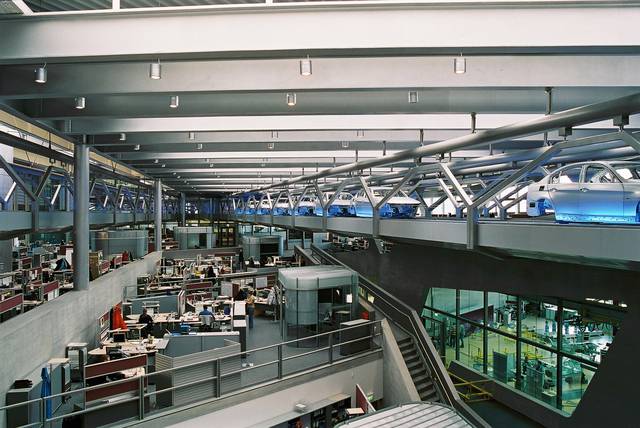
- Parkeisenbahn am Auensee, Gustav-Esche Straße 8 (Tram 10, 11 to Wahren, bus 80 to Auensee, +49 341 461 11 51. operates April–October, M–Sa 14:00–18:00, on Su also 10:00–13:00. Take a ride on a miniature railway circling around the Lake Auensee in the northwest of the city. €6.50 for a family of 4.
- Red Bull Arena. The Red Bull Arena is RasenBallsport Leipzig's home ground. Its average capacity is 45,000 and it usually sells out week in week out for its "Heimspiel". While RB (they are not allowed to be officially named "Red Bull" but everybody knows what the awkward name "Rasenballsport" means) has indeed managed to acquire a fanbase in Leipzig, the very existence of the team is highly controversial with the rather controversial and money-averse German soccer fanbase.
- BMW Werk Leipzig, BMW Allee 1, 04349 Leipzig. The BMW assembly plant in Leipzig, which builds the 1er-series and X1 models, offers guided tours of its premises. They require previous appointment - you need to send a request with your preferences in advance and wait for the Visitor's Centre to get back to you. €6 per person (adult), €130 for an individual tour (for up to 30 persons).
- Porsche Leipzig, Porschestraße 1. The Porsche factory in Leipzig, which builds the Cayenne and the Panamera, offers plant tours as well as driving experiences on the test track, combined with meals at the on-site restaurant. A much wider choice of events is offered to users booking in German, via the German version of the website. Factory tour and brunch from €45.
Parkeisenbahn am Auensee, Gustav-Esche Straße 8 (Tram 10, 11 to Wahren, bus 80 to Auensee, +49 341 461 11 51. operates April–October, M–Sa 14:00–18:00, on Su also 10:00–13:00. Take a ride on a miniature railway circling around the Lake Auensee in the northwest of the city. €6.50 for a family of 4.
Red Bull Arena. The Red Bull Arena is RasenBallsport Leipzig's home ground. Its average capacity is 45,000 and it usually sells out week in week out for its "Heimspiel". While RB (they are not allowed to be officially named "Red Bull" but everybody knows what the awkward name "Rasenballsport" means) has indeed managed to acquire a fanbase in Leipzig, the very existence of the team is highly controversial with the rather controversial and money-averse German soccer fanbase.
BMW Werk Leipzig, BMW Allee 1, 04349 Leipzig. The BMW assembly plant in Leipzig, which builds the 1er-series and X1 models, offers guided tours of its premises. They require previous appointment - you need to send a request with your preferences in advance and wait for the Visitor's Centre to get back to you. €6 per person (adult), €130 for an individual tour (for up to 30 persons).
Porsche Leipzig, Porschestraße 1. The Porsche factory in Leipzig, which builds the Cayenne and the Panamera, offers plant tours as well as driving experiences on the test track, combined with meals at the on-site restaurant. A much wider choice of events is offered to users booking in German, via the German version of the website. Factory tour and brunch from €45.
There are lots of shops in the inner city (city center), mostly frequented by pedestrians. Leipzig and Germany souvenirs can be found at shops around the Old City Hall. Many independent retailers unique to Leipzig can be found in Südvorstadt; with many interesting clothing stores, food places, and cinemas.
- Christmas Market. As in many other German cities, Leipzig hosts the Leipziger Weinachtsmarkt, or Leipzig Christmas Market, which opens in the last week of November, first week of December and continues until a few days before Christmas Day. The Leipzig Christmas Market is a major event in the city and is essentially a large winter-themed carnival, complete with a giant Ferris Wheel on Augustusplatz in between the Opera House and the Gewandhaus, carrousels and other small rides in addition to the usual market stalls and food vendors. The festivities take place throughout the inner city of Leipzig, with a majority of the market stalls stationed on Market Square in front of the Old Town Hall, but also on Petersstraße, Grimmaische Straße and Nikolaistraße next to Nikolai Church. The market stalls sell a variety of gifts unique to the Ore Mountain region south of Leipzig, as well as various traditional market foods such as fried potato pancakes (Kartoffelpuffer), Heurigen (roasted roll with cheese and meat) and Glühwein (a mulled wine). There are also carolers and Christmas-themed events.
- Paunsdorf Center, Paunsdorfer Allee 1 (tram 3 or 7 to Paunsdorf Center, or train to Engelsdorf. M-Th 10:00–20:00, F Sa 10:00–21:00. Large shopping mall that includes C&A, H&M, Esprit.
- Hauptbahnhof, Willy-Brandt-Platz 7. The Hauptbahnhof is not only one of the biggest train stations in Europe, it's a great shopping mall as well (on three floors boutiques and restaurants are located next to drug stores and supermarkets)
- Fresh Food Market. Tuesday and Friday. local vegetables and all kinds of fruits and flowers.
- Fresh Food Market. Saturdays. may be a bit cheaper (mostly lower-grade goods at a lower price and some disount offers) but the atmosphere is not so nice. Sometimes there are market criers around.
- Antik- und Trödelmarkt, Agra Messepark, Bornaische Straße (tram 11 to Dölitz Straßenbahnhof. last weekend of every month, 08:00–15:00.
- Westpaket, Karl-Heine-Straße (tram 3, 13, 14 to Felsenkeller. 4 times a year. a nice alternative fleamarket with approx. 100 booths of locals selling handmade stuff, some antiques and second hand clothes on the pavements. there is also some musics groups and food.
- Nova Eventis, Günthersdorf (west of Leipzig at the crossing of the A9 motorway and the B181 main road. Take bus 131 from Hauptbahnhof (Ostseite) or Angerbrücke, or go by car, following Merseburger Straße out of the city.. M-Th Sa 10:00–20:00, F 10:00–22:00. One of the largest shopping malls in Germany.
Christmas Market. As in many other German cities, Leipzig hosts the Leipziger Weinachtsmarkt, or Leipzig Christmas Market, which opens in the last week of November, first week of December and continues until a few days before Christmas Day. The Leipzig Christmas Market is a major event in the city and is essentially a large winter-themed carnival, complete with a giant Ferris Wheel on Augustusplatz in between the Opera House and the Gewandhaus, carrousels and other small rides in addition to the usual market stalls and food vendors. The festivities take place throughout the inner city of Leipzig, with a majority of the market stalls stationed on Market Square in front of the Old Town Hall, but also on Petersstraße, Grimmaische Straße and Nikolaistraße next to Nikolai Church. The market stalls sell a variety of gifts unique to the Ore Mountain region south of Leipzig, as well as various traditional market foods such as fried potato pancakes (Kartoffelpuffer), Heurigen (roasted roll with cheese and meat) and Glühwein (a mulled wine). There are also carolers and Christmas-themed events.
Paunsdorf Center, Paunsdorfer Allee 1 (tram 3 or 7 to Paunsdorf Center, or train to Engelsdorf. M-Th 10:00–20:00, F Sa 10:00–21:00. Large shopping mall that includes C&A, H&M, Esprit.
Hauptbahnhof, Willy-Brandt-Platz 7. The Hauptbahnhof is not only one of the biggest train stations in Europe, it's a great shopping mall as well (on three floors boutiques and restaurants are located next to drug stores and supermarkets)
Fresh Food Market. Tuesday and Friday. local vegetables and all kinds of fruits and flowers.
Fresh Food Market. Saturdays. may be a bit cheaper (mostly lower-grade goods at a lower price and some disount offers) but the atmosphere is not so nice. Sometimes there are market criers around.
Antik- und Trödelmarkt, Agra Messepark, Bornaische Straße (tram 11 to Dölitz Straßenbahnhof. last weekend of every month, 08:00–15:00.
Westpaket, Karl-Heine-Straße (tram 3, 13, 14 to Felsenkeller. 4 times a year. a nice alternative fleamarket with approx. 100 booths of locals selling handmade stuff, some antiques and second hand clothes on the pavements. there is also some musics groups and food.
Nova Eventis, Günthersdorf (west of Leipzig at the crossing of the A9 motorway and the B181 main road. Take bus 131 from Hauptbahnhof (Ostseite) or Angerbrücke, or go by car, following Merseburger Straße out of the city.. M-Th Sa 10:00–20:00, F 10:00–22:00. One of the largest shopping malls in Germany.
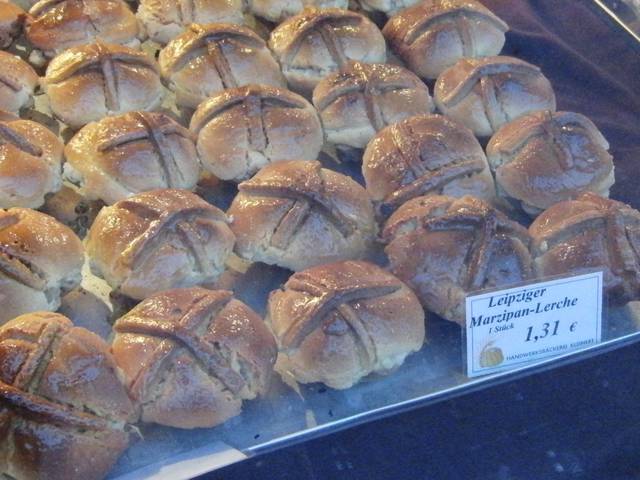 Try specialities of Leipzig:
Try specialities of Leipzig:
- Lerchen, a sweet dough-wicker filled with marzipan, sold in bakeries.
- Quarkkeulchen, served in traditional restaurants as a dessert
- Leipziger Allerlei, a vegetables dish
- Reformationsbrötchen, a pastry, sold in bakeries in October prior to Reformation Day
Lerchen, a sweet dough-wicker filled with marzipan, sold in bakeries.
Quarkkeulchen, served in traditional restaurants as a dessert
Leipziger Allerlei, a vegetables dish
Reformationsbrötchen, a pastry, sold in bakeries in October prior to Reformation Day
For breakfast or for a snack during the day, turn to one of the many bakery shops you'll find all over the city. Most are open 7 days a week, typically from 06:00 to 18:00 (or from 07:00 to 06:00 on Sundays). €5 buys you a sandwich, a pastry or a piece of cake, and a cup of coffee.
- Cafe Sinfonie, Gottschedstraße 15 (Tram: Gottschedstraße.
- Safran, Karl-Liebknecht-Straße. Indian food.
- Sol y Mar, Gottschedstraße 4, +49 341 9615721. M–Sa 09:00–18:00. Ambient place with vegetarian options €5–14.
Cafe Sinfonie, Gottschedstraße 15 (Tram: Gottschedstraße.
Safran, Karl-Liebknecht-Straße. Indian food.
Sol y Mar, Gottschedstraße 4, +49 341 9615721. M–Sa 09:00–18:00. Ambient place with vegetarian options €5–14.
- Apels Garten, Kolonnadenstraße 2 (Tram: Gottschedstraße. Saxon cuisine.
- Barthel's Hof, Hainstraße 1. Exotic Saxon dishes. €8–25.
- India Gate, Nikolaistraße 10. Features a scale model of the Taj Mahal. €7–14.
- Tobagi, Riemannstraße 52 (Tram: Hohe Straße. Korean food.
- Zest, Bornaische Straße 54 (Tram (10 or 11): Pfeffingerstraße, +49 341 2319126. W-M 11:00–23:00. Vegetarian/vegan restaurant. Try the strawberry basil smoothie. €10–15.
- Zills Tunnel, Barfußgäßchen 9. Saxon food. Large portions. Outdoor terrace, rustic cellar, or tunnel courtyard. €9–13.
Apels Garten, Kolonnadenstraße 2 (Tram: Gottschedstraße. Saxon cuisine.
Barthel's Hof, Hainstraße 1. Exotic Saxon dishes. €8–25.
India Gate, Nikolaistraße 10. Features a scale model of the Taj Mahal. €7–14.
Tobagi, Riemannstraße 52 (Tram: Hohe Straße. Korean food.
Zest, Bornaische Straße 54 (Tram (10 or 11): Pfeffingerstraße, +49 341 2319126. W-M 11:00–23:00. Vegetarian/vegan restaurant. Try the strawberry basil smoothie. €10–15.
Zills Tunnel, Barfußgäßchen 9. Saxon food. Large portions. Outdoor terrace, rustic cellar, or tunnel courtyard. €9–13.
- Medici, Nikolaikirchhof 5. Classy Italian restaurant 3–5 course set: €46–62.
- Stadtpfeiffer, Augustusplatz 8 (inside Gewandhaus, +49 341 2 17 89 20. Tu-Sa from 18:00; closed in July and August. 4 course set: €108.
Medici, Nikolaikirchhof 5. Classy Italian restaurant 3–5 course set: €46–62.
Stadtpfeiffer, Augustusplatz 8 (inside Gewandhaus, +49 341 2 17 89 20. Tu-Sa from 18:00; closed in July and August. 4 course set: €108.
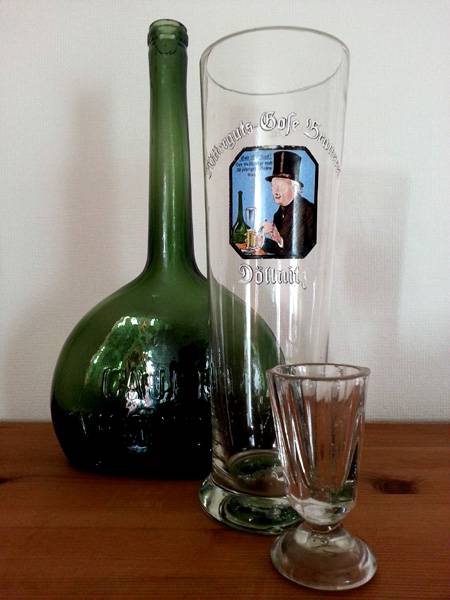 A local beer specialty is Leipziger Gose, a top-fermented brew with a characteristic, slightly sour flavour, that originated from Goslar but was immensely popular in Leipzig during past centuries. It has however become rather rare and is only served in a few specialised breweries and pubs nowadays. Today, most Leipzigers prefer more mainstream Pils beers and if you just order "a beer" you will most probably get a Pils by default. Ur-Krostitzer, for example, is brewed just a few kilometers north of Leipzig and was purportedly favoured by the Swedish king Gustavus Adolphus during his stay in the region. Leipzig's Sternburg Export is one of the cheapest among German beer brands (c. 50 cents a bottle in most supermarkets) and is prefered by the young and poor who want to get lit for little money, while only a few enthusiasts actually appreciate its taste.
A local beer specialty is Leipziger Gose, a top-fermented brew with a characteristic, slightly sour flavour, that originated from Goslar but was immensely popular in Leipzig during past centuries. It has however become rather rare and is only served in a few specialised breweries and pubs nowadays. Today, most Leipzigers prefer more mainstream Pils beers and if you just order "a beer" you will most probably get a Pils by default. Ur-Krostitzer, for example, is brewed just a few kilometers north of Leipzig and was purportedly favoured by the Swedish king Gustavus Adolphus during his stay in the region. Leipzig's Sternburg Export is one of the cheapest among German beer brands (c. 50 cents a bottle in most supermarkets) and is prefered by the young and poor who want to get lit for little money, while only a few enthusiasts actually appreciate its taste.
A local liquor specialty is Leipziger Allasch, a kümmel (caraway-flavoured liquor), and a variety of liquors of Horn's destillery.
You can find a lot of pubs, bars, cafés and restaurants and also some smaller dance clubs along the multicultural Karl-Liebknecht-Straße ("Karli"). The street starts in the south of the inner city and leads you to Südvorstadt and Connewitz (student and alternative quarters). Many pubs, bars and cafés can also be found on Barfußgässchen., a narrow lane in the old town.
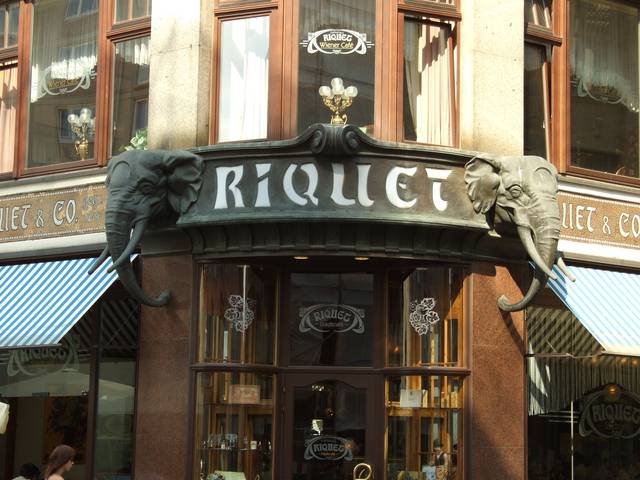 Leipzig has a long and lively coffee house tradition. Although many of the old cafés have disappeared, this tradition lives on. Besides Zum Arabischen Coffee Baum (listed under Museums above) a number of cafés give you a place to relax and have a cup of coffee during the day.
Leipzig has a long and lively coffee house tradition. Although many of the old cafés have disappeared, this tradition lives on. Besides Zum Arabischen Coffee Baum (listed under Museums above) a number of cafés give you a place to relax and have a cup of coffee during the day.
- Riquet, Schuhmachergäßchen 1 (city center, +0341 9 61 00 00. 09:00–20:00. Built in 1908-09. Two copper elephant heads guard the entrance. The interior is put under preservation and has been restored to its original glory in the 1990s. Wide selection of cakes and gateaux.
- Café Grundmann, August-Bebel-Straße 2 (tram 10, 11 to Südplatz, then follow Schenkendorfstraße. Art-deco style. Opened in 1919, refurbished in 1998–2000. Outside the city center.
Riquet, Schuhmachergäßchen 1 (city center, +0341 9 61 00 00. 09:00–20:00. Built in 1908-09. Two copper elephant heads guard the entrance. The interior is put under preservation and has been restored to its original glory in the 1990s. Wide selection of cakes and gateaux.
Café Grundmann, August-Bebel-Straße 2 (tram 10, 11 to Südplatz, then follow Schenkendorfstraße. Art-deco style. Opened in 1919, refurbished in 1998–2000. Outside the city center.
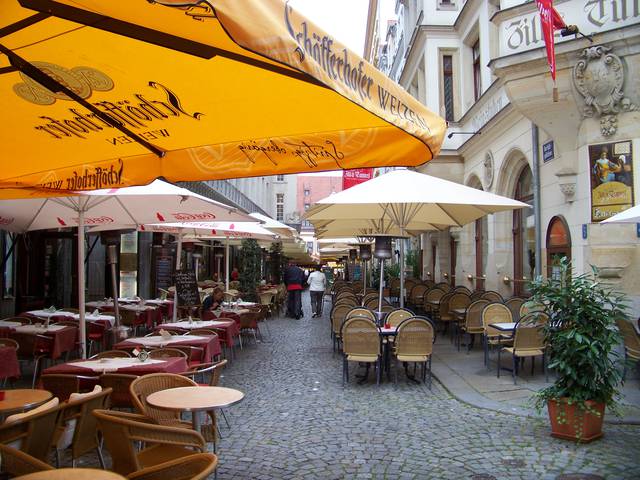
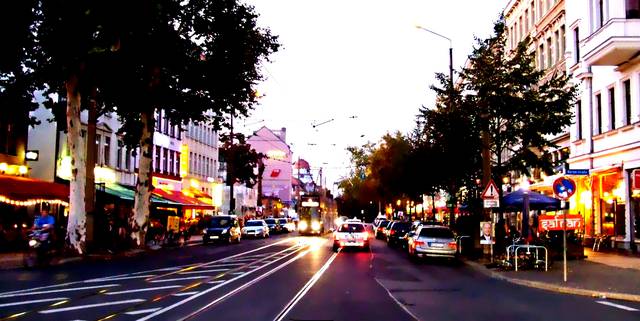
- Auerbachs Keller, Mädler Passage, Grimmaische Straße 2-4, +49 341 21610-0. This pub has been around since medieval times. Opened in 1525, it is among the oldest continuously operated pubs in Germany. The barrel cellar (only opened for private parties) has been the background to a scene in one of Germany's most famous plays, "Faust" by Goethe. The master of German literature himself used to drink his wine here, and the rooms are frequently the set for a live, around-the-city re-enactment of the play. Expensive.
- Chocolate, Gottschedstraße 1. Sleek design.
- Gosenschenke Ohne Bedenken, Menckestraße 5 (Tram 12 to Fritz-Seger-Straße. Includes the city's prettiest beer garden but not many vegetarian options. Try their beer specialty 'Gose'. It's made with coriander and salt, and is very much an acquired taste. It is usually served with a shot of liquor. Food: €6–16.
- Sixtina, Sternwartenstraße 4. Has the largest number of different brands of absinthe.
- Tonelli's, Neumarkt 9. Right in the centre of town. Good German food and drink at a low price. A local mainstay. The only location that offers live music Monday to Saturday starting at 21:00. Tuesdays is "Guitarnight" with guitar guru Christian Rover and occasional international guests, Thursdays the blues scene meets, changing events on other nights.
- Volkshaus, Karl-Liebknecht-Straße 32 (Tram: Hohe Straße, LVB. Always a happening place. DJs, football games, and partying all night.
- Spizz, Am Markt 9 (S-Bahn: Markt. Right in the centre of town. Popular with all age groups. A place to see and be seen. Also a jazz bar with brass instruments hanging from the ceiling.
Auerbachs Keller, Mädler Passage, Grimmaische Straße 2-4, +49 341 21610-0. This pub has been around since medieval times. Opened in 1525, it is among the oldest continuously operated pubs in Germany. The barrel cellar (only opened for private parties) has been the background to a scene in one of Germany's most famous plays, "Faust" by Goethe. The master of German literature himself used to drink his wine here, and the rooms are frequently the set for a live, around-the-city re-enactment of the play. Expensive.
Chocolate, Gottschedstraße 1. Sleek design.
Gosenschenke Ohne Bedenken, Menckestraße 5 (Tram 12 to Fritz-Seger-Straße. Includes the city's prettiest beer garden but not many vegetarian options. Try their beer specialty 'Gose'. It's made with coriander and salt, and is very much an acquired taste. It is usually served with a shot of liquor. Food: €6–16.
Sixtina, Sternwartenstraße 4. Has the largest number of different brands of absinthe.
Tonelli's, Neumarkt 9. Right in the centre of town. Good German food and drink at a low price. A local mainstay. The only location that offers live music Monday to Saturday starting at 21:00. Tuesdays is "Guitarnight" with guitar guru Christian Rover and occasional international guests, Thursdays the blues scene meets, changing events on other nights.
Volkshaus, Karl-Liebknecht-Straße 32 (Tram: Hohe Straße, LVB. Always a happening place. DJs, football games, and partying all night.
Spizz, Am Markt 9 (S-Bahn: Markt. Right in the centre of town. Popular with all age groups. A place to see and be seen. Also a jazz bar with brass instruments hanging from the ceiling.
- Conne Island, Koburger Straße 3 (In the suburb of Connewitz, Tram 9 to Koburger Brücke. Former squat house, now a top venue for punk, rock, ska, and hip-hop concerts.
- Dark Flower, Hainstraße 12–14. gothic music and dark wave, on Thursday rock music.
- Distillery, Kurt-Eisner-Straße 108a, 04275 Leipzig. Originally a pure techno club, the music program nowadays also includes genres such as drum and bass, hip-hop and reaggae.
- Elipamanoke, Markranstädter Str. 4, 04229 Leipzig. Dark and dirty techno club with two floors in an old industrial building in the Plagwitz district.
- Flowerpower, Bernhard-Göring-Straße 16. Weirdly decorated place with hippie 1970s theme. Mostly classic rock. Party lasts well past 04:00.
- Ilses Erika, Bernhard-Göring-Straße 152 (Tram: Wiedebachplatz. Small club features indie and electronic music. Student crowd.
- Institut für Zukunft, An den Tierkliniken 38–40, 04103 Leipzig. Industrial-style techno club in a former cold store, playing techno on the lower floor, and house on the upper floor.
- Moritzbastei & Cafe Barbakane, Universitätsstraße 9 (Tram: Roßplatz. Very old and big student club bar and cafe. Underground cellars. Live bands or DJs most nights, outdoor films are shown in the summer. Moritzbastei was once a part of the city wall. Students dug it out in the 1970s and turned it into a club.
- naTo, Karl-Liebknecht-Straße 48 (Tram 10 or 11 to Südplatz, +49 341 30143 97. Jazz, experimental, and indie music. Also shows film and theatre.
- Werk II, Kochstraße 132. In an old factory, now used for concerts, film, theatre, and circus acts.
Conne Island, Koburger Straße 3 (In the suburb of Connewitz, Tram 9 to Koburger Brücke. Former squat house, now a top venue for punk, rock, ska, and hip-hop concerts.
Dark Flower, Hainstraße 12–14. gothic music and dark wave, on Thursday rock music.
Distillery, Kurt-Eisner-Straße 108a, 04275 Leipzig. Originally a pure techno club, the music program nowadays also includes genres such as drum and bass, hip-hop and reaggae.
Elipamanoke, Markranstädter Str. 4, 04229 Leipzig. Dark and dirty techno club with two floors in an old industrial building in the Plagwitz district.
Flowerpower, Bernhard-Göring-Straße 16. Weirdly decorated place with hippie 1970s theme. Mostly classic rock. Party lasts well past 04:00.
Ilses Erika, Bernhard-Göring-Straße 152 (Tram: Wiedebachplatz. Small club features indie and electronic music. Student crowd.
Institut für Zukunft, An den Tierkliniken 38–40, 04103 Leipzig. Industrial-style techno club in a former cold store, playing techno on the lower floor, and house on the upper floor.
Moritzbastei & Cafe Barbakane, Universitätsstraße 9 (Tram: Roßplatz. Very old and big student club bar and cafe. Underground cellars. Live bands or DJs most nights, outdoor films are shown in the summer. Moritzbastei was once a part of the city wall. Students dug it out in the 1970s and turned it into a club.
naTo, Karl-Liebknecht-Straße 48 (Tram 10 or 11 to Südplatz, +49 341 30143 97. Jazz, experimental, and indie music. Also shows film and theatre.
Werk II, Kochstraße 132. In an old factory, now used for concerts, film, theatre, and circus acts.
Karl-Liebknecht-Straße ("Karli"). The street starts in the south of the inner city and leads you to Südvorstadt and Connewitz (student and alternative quarters). Many pubs, bars and cafés can also be found on Barfußgässchen., a narrow lane in the old town.
- Consulate Generals and other foreign authorities in Leipzig. Online list maintained by tourist information.
- Ludwig Press Shop. Broad selection of international newspapers
- Polizeirevier Innenstadt, Ritterstraße 17-21, +49 341 7105-0. Police station city center
- Polizeirevier Mitte, Dimitroffstr. 1, +49 341 966-34299. Police station for central districts around the immediate center
- Bundespolizei Hauptbahnhof, Willy-Brandt-Platz 2c (central station, platform level, near platform 2, +49 341 997990.
- Lost Property Office, Technisches Rathaus, Prager Straße 130 (tram 12 or 15 to Prager/Riebeckstraße; take the side entrance between blocks A and B of the administration building, +49 341-123-8400. Tu 09:00–12:00 and 13:00–18:00.
- Railway Lost Property Office, Willi-Brandt-Platz 7 (Hauptbahnhof, Querbahnsteig, near western side exit, +49 341-9683255. 06:00–22:00. If you lost something on a train or in a station.
Consulate Generals and other foreign authorities in Leipzig. Online list maintained by tourist information.
Ludwig Press Shop. Broad selection of international newspapers
Polizeirevier Innenstadt, Ritterstraße 17-21, +49 341 7105-0. Police station city center
Polizeirevier Mitte, Dimitroffstr. 1, +49 341 966-34299. Police station for central districts around the immediate center
Bundespolizei Hauptbahnhof, Willy-Brandt-Platz 2c (central station, platform level, near platform 2, +49 341 997990.
Lost Property Office, Technisches Rathaus, Prager Straße 130 (tram 12 or 15 to Prager/Riebeckstraße; take the side entrance between blocks A and B of the administration building, +49 341-123-8400. Tu 09:00–12:00 and 13:00–18:00.
Railway Lost Property Office, Willi-Brandt-Platz 7 (Hauptbahnhof, Querbahnsteig, near western side exit, +49 341-9683255. 06:00–22:00. If you lost something on a train or in a station.
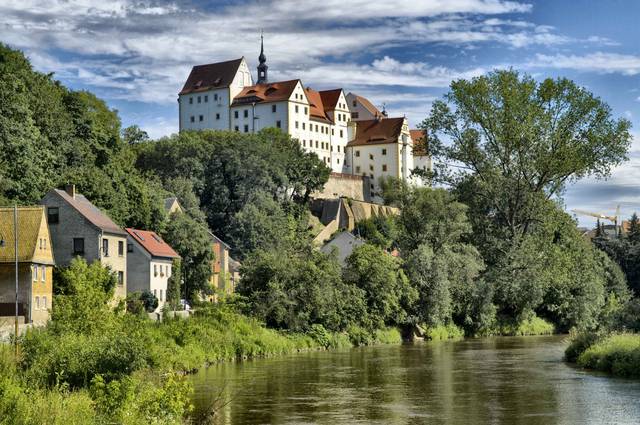
- Lützen — about 20 km southwest, where two great battles have been fought during the Thirty Years' and the Napoleonic Wars, and where Gustavus Adolphus, one of the most famous kings of Sweden died in the Thirty Years War. Birthplace of the philosopher Friedrich Nietzsche.
- Merseburg – more than thousand-year-old town with interesting old centre, Romanesque/Gothic cathedral and Renaissance palace (30 km west)
- Halle — Leipzig's "twin city" some great things to see. Largest city in Saxony-Anhalt, birthplace of Händel and has a few castles. The city's are linked by frequent local trains (40 km northwest)
- Colditz – known for its castle that was used as a prisoners-of-war camp during World War II (50 km southeast)
- Naumburg with its impressive Romanesque cathedral, home town of philosopher Friedrich Nietzsche, centre of the Saale-Unstrut cultural landscape and wine-growing region can be reached in 20–25 minutes by train (60 km southwest)
- Dessau – former residence of the small principality of Anhalt; both the beautiful Dessau-Wörlitz "garden realm" and the Bauhaus school that pioneered modern architecture and arts are UNESCO World Heritage sites (70 km north)
- Lutherstadt Wittenberg — one of the most important sites of Protestant Reformation, is just half an hour away in ICE trains (75 km north)
- Dresden — a must-see with its old baroque center, the Frauenkirche and its other attractions. Go there in just over an hour by train or car (120 km east)
- Weimar — Germany's "classical city", where several poets, philosophers and artists of the classical era lived and worked, is little more than an hour away by train (130 km southwest)
- Erfurt — the state capital of Thuringia with its medieval old town is just 45 minutes away by high-speed train (145 km southwest)
- Berlin — the German capital is an hour away by ICE train (190 km north)
